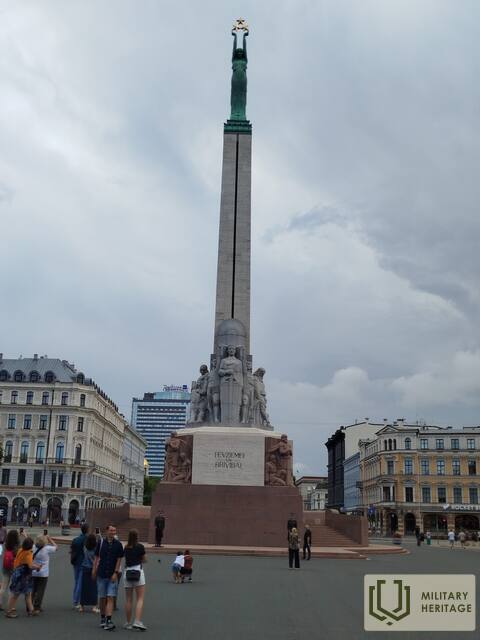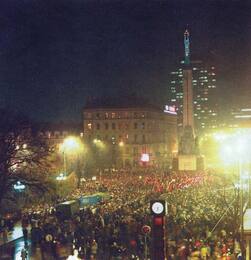The fate of the Freedom Monument during the Soviet era
During the Soviet occupation, the Soviet authorities wanted to dismantle the Freedom Monument, but legend has it that Soviet sculptor Vera Mukhina advocated for the preservation of the monument, emphasizing its artistic and emotional value to the Latvian people.
After the occupation of Latvia in 1940, the Freedom Monument was in serious danger. There are oral sources that the Soviet authorities considered demolishing it, but did not do so. Legend has it that the Soviet sculptor Vera Mukhina — born in Riga and famous for her work "Worker and Kolkhoz Woman" — advocated for the preservation of the monument, emphasizing its artistic and emotional value to the Latvian people.
Although Soviet ideologists tried to reinterpret the symbols (for example, the three stars as a symbol of the Baltic Soviet republics), among the people the monument always remained a symbol of freedom and independence.
According to the recollections of Mukhina's son: she participated in a meeting where her opinion was asked, and she stated that the monument was of "outstanding artistic value" and its destruction "would offend the most sacred feelings of the Latvian people."
However, there are no official documents confirming this claim - the information is based on word of mouth and secondary sources.
Vera Mukhina was one of the central figures in Soviet republican sculpture — her work “Worker and Collective Farmer” (1937) was recognized as an iconic symbol of Soviet art.
She was awarded the Stalin Prize several times - five times: in 1941, 1943, 1946, 1951, 1952. She was involved in official state events, received prestigious monumental orders, and was a People's Artist of the Soviet Union.
Related objects
Freedom Monument in Riga
The Freedom Monument was one of the central symbolic points of the Awakening events. On June 14, 1987, the human rights group Helsinki-86 organized an unauthorized public flower-laying ceremony at the Freedom Monument. Two months later, on August 23, Helsinki-86 called for a rally at the Freedom Monument on the 48th anniversary of the Hitler-Stalin Pact of August 23, 1939. During this rally, Soviet police beat and arrested demonstrators. In the following years, flower-laying ceremonies at the Freedom Monument became a part of all major demonstrations and other mass events .
Located in the center of Riga, on Freedom Square.
The Freedom Monument is one of the most outstanding monuments of Latvian history, architecture and art. Built according to the project of Kārlis Zāle with public donations. It was unveiled in 1935 as a symbol of the Latvian people's freedom and love of their homeland. Together with the Riga Brothers' Cemetery ensemble, it belongs to the most valuable examples of monumental architecture and sculpture.
The Freedom Monument expresses the ethical and aesthetic values of Latvian culture. The symbols reflect the philosophical essence of freedom and the historical ideas of the Latvian nation about the stages of the struggle for independence. They point to the embodiment of physical and spiritual strength. The heroic language tells the story of the Latvian people as self-reliant, active creators of history and the determinants of their own destiny.
In its place, there was originally a monument to Russian Tsar Peter I. During World War I, it was dismantled to be transported by ship to Petrograd. The ship was torpedoed by a German submarine, and it sank off the Estonian island of Vormsi. The Soviet occupation regime planned to demolish the Freedom Monument several times, but this did not happen.
Today, you can see one of the symbols of Latvia and observe the traditions of the army honor guard.
A tactile Freedom Monument has been created on the canal bank, next to the Freedom Monument. This special bronze miniature was created by sculptor Ivars Miķelsons on a scale of 1:50.






